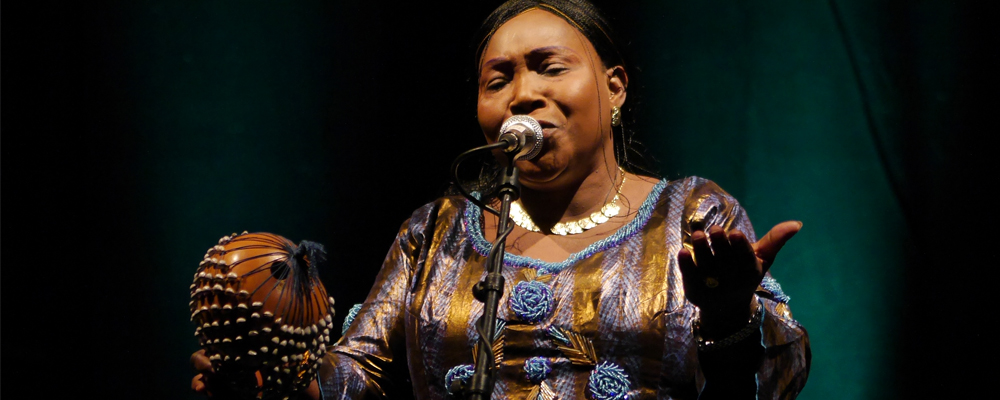Impact masterclass
Curating new expressions of Mali’s musical heritage
UoA33 – Music, Drama, Dance, Performing Arts, Film and Screen Studies

If structured poorly, the impacts presented in a case study can be reminiscent of a random ripple effect. This can leave the reader confused and unconvinced. Yet when the story is unfolded with clarity and intention, the same material can make a powerful, coherent narrative arc – essential for showcasing the Reach and Significance of the impacts to best effect.
To illustrate this, I have chosen an outstanding example, notable for way that the narrative reveals a wide range of beneficiaries and impacts while leaving the reader comfortable that everything they read is part of the same story.
Setting the scene: show why the research was important
In this case study, Professor Lucy Duran, a leading expert on the music of West Africa, knits together several strands of her research into the history, practices and cultural significance of the traditional music of Mali – a musical heritage at risk of disappearing. The story of how this research led to a wide range of impacts is nothing if not compelling.
The underpinning research began as far back as 1993 – way before the research assessment period for the REF2021.
This could have resulted in an overwhelming level of detail, but Duran uses the second paragraph of Section 2 to summarise how, as Mali’s traditional music became more endangered, her research evolved and helped to protect it by taking it to a wider audience.
Weave figures and quotes into the narrative
The key REF question, ‘what would not have happened without this research’, is neatly answered by justifiably describing the musical collaborations engineered by Duran as “unique”. In Section 4, the case study unfolds the enormous diversity of beneficiary groups and the interesting ways they have benefited – with plenty of quotes illustrating just how much of a difference Duran’s work has made to a wide range of people, alongside key figures demonstrating astonishing Reach.
Some of the research outputs were musical performances. To underline the Reach of their impact, the narrative does, of course, include audience sizes (quantitative evidence). Recordings of the concerts were later turned into an album, a process that neatly demonstrates the route to the impact the music had on much wider audiences. The Significance of this impact is evidenced by quotes from some of the glowing media reviews this work received, alongside a quote from a professional musician. These voices, of which there are plenty in the case study, provide the qualitative evidence of impact that every case study needs.
Bring out the diversity of impact types
I was interested to see that the case study claimed an unusual impact type, the exchange of cultural traditions. This clearly counts as impact as it involves behaviour change, and I thought it was good to see it expressed like this. Several quotations, from a mix of European and African performers and collaborators clearly demonstrate how the project transformed their performance practice in unique ways.
Other beneficiary groups mentioned include young players in string quartets. These were impacted through the outreach projects of one of the principal research collaborators, the Kronos string quartet. Duran convincingly illustrates how the activities of Kronos supported the broader impacts of her research. The text even includes a quote from a young musician based in the USA, confirmation that Duran collected her impact evidence wherever it appeared.
Take the assessor to an unexpected (but relevant) place
A final, unforeseen (by me), area of impact was on cultural producers, in this case those working on the remake of the TV series, Roots. Duran’s success in showcasing Malian music through her research led to her appointment as cultural adviser to the producers. In addition some of the performers from the album were asked to play on the programme’s soundtrack. These impacts were interesting in their own right, but the fact that the producers were aware of the research outputs (the album) is another indicator of the very considerable Reach of Duran’ research.
By carefully setting the scene, highlighting a wide range of different beneficiaries, balancing quantitative and qualitative evidence, and showcasing both expected and unexpected impact types, Duran’s case study presents a coherent, persuasive and memorable account of the impacts achieved. Unsurprisingly, it received a well-deserved 4* rating.
Image: Trio D Kali, a griot music group from Mali, playing at a world music concert in Germany. Credit Thorsten Krienke/CC BY-SA 2.0
Next impact masterclass
Neural machine translation improves translation quality
UoA11- Computer Science and Informatics
This case study reminded me how significant and wide-ranging impacts from research can be.
Find out more about Neural machine translation improves translation quality
Ready to create impact?
To discuss REF 2029 or find out how we can help with your training needs contact Kristine Pommert.